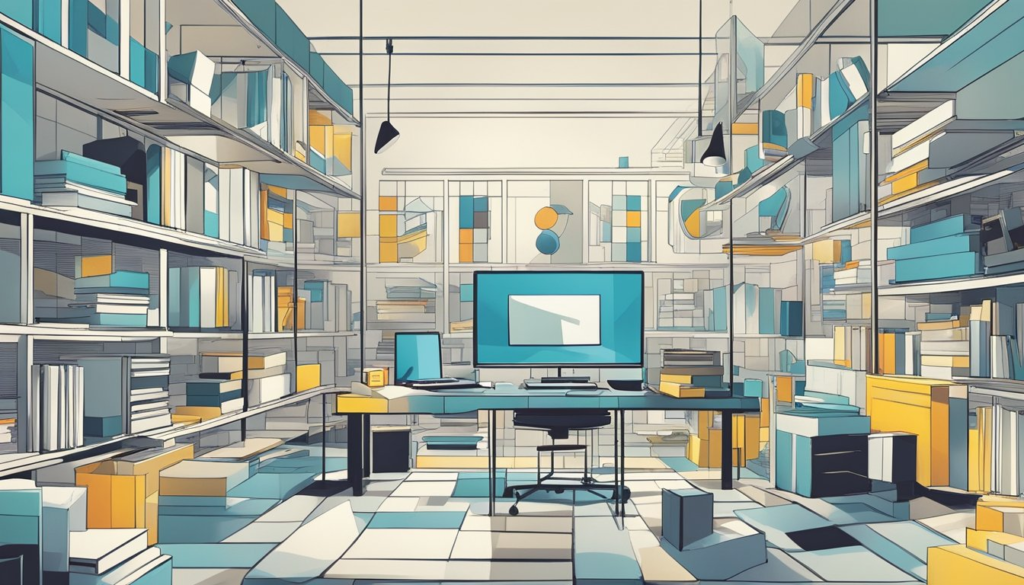Visual hierarchy is one of the foundational principles of graphic design, guiding how viewers process and engage with visual content. It refers to the arrangement of elements in a way that establishes an order of importance, ensuring that the most critical information is seen first and understood clearly.
A strong visual hierarchy leads the viewer’s eye through the design, helping them make sense of the message without overwhelming them. In this guide, we will explore what visual hierarchy is, why it’s important, and how to effectively apply it in your design work.
What is Visual Hierarchy?
Visual hierarchy is the process of organizing design elements based on their level of importance, helping guide the viewer’s attention through a composition. It influences how information is processed, allowing viewers to quickly identify the most significant elements on the page.
In design, visual hierarchy is typically created through variations in size, color, contrast, alignment, and spacing. For example, in a typical webpage or poster, the title is often the largest element, followed by subheadings, and then body text, each progressively smaller in size.
Key Components of Visual Hierarchy:
- Size: Larger elements are more likely to catch attention.
- Color: Bright or contrasting colors stand out more than muted tones.
- Typography: Bold, unique, or larger fonts draw more focus.
- Positioning: Elements placed at the top or center of a design are noticed first.
- Spacing: White space around an element can highlight its importance.
These components work together to help designers convey messages clearly, ensuring that viewers engage with content in the intended sequence.
Why is Visual Hierarchy Important?
1. Guides Viewer Attention
Visual hierarchy dictates the path a viewer’s eye takes through a design, ensuring they focus on the most important elements first. For example, a headline might capture initial attention, followed by a supporting image, and then the body text. By using hierarchy strategically, you can ensure that key information is not missed.
2. Improves Readability and Accessibility
A well-structured design is easier to read and navigate. By breaking content into digestible chunks and organizing it with a clear hierarchy, you make it easier for viewers to understand complex information. Hierarchical structures allow users to quickly scan content, which is especially important for websites and digital interfaces where users tend to skim rather than read every word.
3. Enhances User Experience
Good visual hierarchy enhances the overall user experience by making content intuitive and easy to follow. Whether it’s a website, a brochure, or a product package, a clear structure reduces cognitive load, allowing users to absorb the content effortlessly.
4. Conveys Brand Values and Tone
The way you organize elements in a design can communicate the tone and values of a brand. For instance, a bold, oversized heading with minimal text can suggest confidence and simplicity, while a more intricate, detailed hierarchy might convey elegance and sophistication. Visual hierarchy, therefore, plays a key role in shaping brand perception.
How to Create Strong Visual Hierarchy
To create a strong visual hierarchy in your designs, consider the following techniques:
1. Size and Scale
The simplest way to establish hierarchy is by varying the size of elements. Larger elements naturally draw more attention. Typically, you would make the most important element—such as a title or headline—the largest, with progressively smaller elements for subheadings and body text.
Example:
- Headline: Large, bold font (e.g., 36pt).
- Subheadings: Medium size font (e.g., 24pt).
- Body text: Smaller, readable font (e.g., 14pt).
2. Contrast
Contrast can be created through color, brightness, or typography. High contrast between elements helps important information stand out. For instance, a bold black title against a light background will naturally command attention, while a muted color scheme can draw attention to specific areas through contrast.
Techniques for Contrast:
- Use bright colors for important calls to action.
- Create contrast between headings and body text with bold vs. regular fonts.
- Combine light and dark shades to highlight key elements.
3. Color
Color is a powerful tool for directing attention in design. Bright or bold colors tend to attract the eye, while neutral or subdued colors recede into the background. Use color strategically to emphasize key areas of a design, such as buttons, important messages, or focal points.
Example:
- A bright red button might signify urgency, while a calm blue background can suggest professionalism.
4. Typography
Different fonts, font sizes, and font weights can be used to establish hierarchy in a design. A headline might use a bold, eye-catching font, while the body text uses a more neutral or smaller typeface. Combining serif and sans-serif fonts can also create visual interest and establish a clear hierarchy.
Tips for Typography:
- Use no more than two to three font styles in a single design.
- Employ bold or italic styles to add emphasis where needed.
- Ensure that text is legible across different sizes and devices.
5. Positioning and Alignment
Where you place elements on the page can significantly affect the hierarchy. People naturally read from top to bottom and left to right (in most cultures), so placing important elements in these areas can ensure they’re seen first. Additionally, central alignment often draws more focus than elements placed on the edges of a design.
Example:
- A headline at the top of a page, centered or aligned to the left, ensures it gets noticed first.
6. Whitespace
Whitespace (or negative space) refers to the areas of a design left empty on purpose. This space allows elements to “breathe,” giving them more focus and clarity. Proper use of whitespace prevents clutter and helps viewers easily process the information presented.
Tips for Whitespace:
- Don’t overcrowd elements; allow sufficient space around headings, images, and text.
- Use whitespace to isolate important elements and create a sense of luxury or elegance.
- Avoid filling every corner of the design with content—strategic emptiness can be powerful.
7. Imagery and Iconography
Using strong imagery or icons can create focal points that enhance visual hierarchy. Images naturally draw attention and can guide viewers through the content if placed strategically. For example, a large, high-quality image near the top of a design might pull attention before leading viewers to the headline or accompanying text.
Best Practices:
- Ensure images are relevant and support the message.
- Use high-quality visuals that enhance the overall design.
- Avoid overwhelming the design with too many images, which can reduce clarity.
Examples of Visual Hierarchy in Action
1. Website Design
On a typical webpage, the visual hierarchy might look like this:
- Header: Large, bold heading with a strong call to action (e.g., “Sign Up Now”).
- Subheadings: Medium-sized, supporting text introducing the main content.
- Body Text: Smaller, more detailed information about the product or service.
- Call to Action (CTA): A brightly colored button that stands out, encouraging users to take action.
2. Poster Design
In poster design, visual hierarchy might appear as:
- Title: Oversized font at the top to grab attention.
- Main Image: A prominent image or illustration that reinforces the event or message.
- Supporting Details: Smaller text blocks with event details or contact information placed below the title.
3. Business Card Design
In business card design:
- Name: The largest element, typically in bold or unique typography.
- Contact Information: Smaller text with phone numbers, emails, and addresses.
- Company Logo: Positioned to balance the layout but not overpower the name or contact details.
Conclusion
Visual hierarchy is essential to successful graphic design because it ensures that your audience processes the most important information first. By carefully organizing and prioritizing elements such as size, color, typography, and spacing, you can create a clear path for the viewer’s eye, improving readability, user experience, and engagement.
Understanding and applying visual hierarchy will elevate your designs, helping them stand out, communicate effectively, and make a lasting impact on your audience.
Frequently Asked Questions (FAQ)
1. What is visual hierarchy in graphic design?
Visual hierarchy refers to the arrangement of design elements based on their importance. It guides viewers’ attention through a composition, ensuring that the most critical information is seen first and understood clearly.
2. How does visual hierarchy improve user experience?
By organizing elements in a way that prioritizes key information, visual hierarchy makes content easier to navigate and digest, reducing cognitive load and improving the overall user experience.
3. What are the key principles of visual hierarchy?
The key principles include size, color, contrast, typography, positioning, and whitespace. These elements work together to guide the viewer’s attention and establish a clear flow through the design.
4. How do you create visual hierarchy with typography?
Typography hierarchy can be created by using different font sizes, weights, and styles. Larger, bolder fonts should be used for headlines, while smaller, lighter fonts can be used for supporting text. Combining serif and sans-serif fonts can also create contrast and interest.
5. What is the role of color in visual hierarchy?
Color helps highlight important elements in a design. Bright or bold colors attract more attention, while muted or neutral colors recede. Using contrasting colors can help direct focus to key elements such as buttons or headlines.
6. Why is whitespace important in visual hierarchy?
Whitespace helps prevent clutter and gives design elements space to breathe. It isolates key components, drawing attention to them and improving readability by making the design more organized and less overwhelming.

